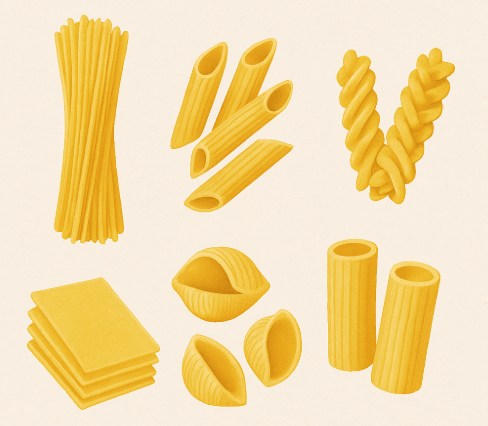Table of Content
Introduction
What is Pasta?
Pasta is an iconic staple of Italian cuisine, beloved worldwide for its delicious simplicity and versatility. Essentially, pasta is dough made from durum wheat flour, known as semolina, mixed with water or eggs and shaped into countless delightful forms.
History of Pasta
The story of pasta goes back a long way, with evidence showing that people have enjoyed it since ancient Rome and Greece. However, the pasta we know and love today started to take shape during the Middle Ages in Italy, particularly in places like Sicily. Over the years, pasta has become a key part of what makes Italian cuisine so special.
What is Pasta Made of?
Traditionally, pasta dough is made from semolina flour, which comes from durum wheat. This type of flour is famous for its high gluten and protein levels, giving pasta that ideal texture and consistency we all love. You might also come across variations like fresh egg pasta or gluten-free options made from rice or legumes.
Why are There Different Shapes?
Italian pasta comes in hundreds of shapes designed for specific sauces, textures, and regional traditions. Each shape serves a unique culinary purpose: Long strands complement smooth sauces, short shapes capture chunky sauces, and filled or dumpling-style pasta provides distinct textures and flavors.
Types of Italian Pasta
1. Long Pasta
Long pasta varieties, such as spaghetti, linguine, fettuccine, and bucatini, are typically thin, long strands perfect for silky, smooth sauces. Their length allows the sauce to coat evenly, providing consistent flavor in every bite.
- Spaghetti: Ideal for tomato-based sauces or simple olive oil, garlic, and chili preparations.
- Linguine: Best served with seafood sauces or pesto.
- Fettuccine: Known for creamy sauces like Alfredo.
2. Short Pasta
Short pasta types, including penne, rigatoni, farfalle, and fusilli, are excellent at capturing chunky sauces or baked dishes. Their unique shapes and ridges hold sauces well, enhancing the overall taste.
- Penne: Great with thick, hearty tomato or cream-based sauces.
- Rigatoni: Perfect for baked pasta dishes due to its robust shape.
- Farfalle (Bow-tie): Wonderful with creamy or vegetable-based sauces.
3. Sheet Pasta
Sheet pasta is primarily used in layered dishes such as lasagna. This flat pasta perfectly supports heavy fillings like ricotta, meat sauces, and vegetables, absorbing flavor and moisture for delicious, comforting meals.
- Lasagna Sheets: Essential for the classic layered lasagna dish with meat, cheese, and tomato sauce.
4. Filled Pasta
Filled pasta, such as ravioli, tortellini, and agnolotti, features delicate dough encasing flavorful fillings like cheeses, meats, seafood, or vegetables. They are often served with lighter sauces to highlight their distinct fillings.
- Ravioli: Often stuffed with ricotta cheese and spinach, served in tomato or butter sauces.
- Tortellini: Smaller, ring-shaped pasta commonly filled with meat or cheese, typically enjoyed in broths or creamy sauces.
5. Dumpling Pasta
Dumpling pasta includes soft, pillowy forms like gnocchi, usually made from potatoes and flour. Their soft texture pairs beautifully with rich, hearty sauces or simple butter and sage preparations.
- Gnocchi: Ideal with pesto, tomato sauces, or buttery sage sauces, offering comforting bites of pillowy perfection.
Embracing Pasta Culture
Italian pasta isn’t just food—it’s an enduring cultural tradition that brings families together, enriches festive celebrations, and transforms everyday dining into memorable experiences. At A-Mano in Orpington, we passionately honor this heritage by handcrafting authentic pasta dishes, infused with time-honored recipes and genuine Italian warmth. Each bite at A-Mano offers a culinary journey, whisking your senses away to Italy. Explore our menu, and savor the true spirit of Italy, one unforgettable pasta dish at a time.
